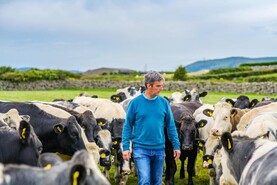Heat detection: Breeding has just kicked off for many, with cows that go in-calf this week hopefully calving in the last days of January/early February. An early turnout and settled weather have, for the most part, left cows in good body condition which should see good heats and conception to first service.
Heat detection can be troublesome where AI is being used either fully or for the first weeks of breeding, though nearly everyone using AI has some means of heat detection beyond that of frequent checking. Vasectomised bulls with a chin ball harness work very well, particularly towards the end of the season when cow heat activity slows down with more cows being in-calf. The issue is if you haven’t a vasectomised bull already on farm, carrying out a vasectomy on a full bull in the morning wouldn’t leave them in a workable condition for eight weeks. Bulls already vasectomised can be purchased, but be cautious around biosecurity risks and that the bull has been properly vasectomised to avoid the teaser bull actually putting cows in calf.
Other options, such as tail paint or pressure pads that change colour from pressure of mounting, can also work well. Ensure frequent topping up of tail paints. Even with visual aids or a vasectomised bull, frequent checking of stock for 10-15 minutes several times a day is necessary.
Grassland management: Grass growth on some drystock farms is still struggling. I know a portion of farmers who have only recently let all cattle out, as grass growth in March in particular was behind normal levels. Growth will now exceed demand (if it hasn’t already done so) on farms in the next two weeks, so a management plan needs to be in place.
Sticking to the rotation (grazing each paddock in the same order as they were last grazed) will not work from a grassland management point of view, as each paddock will grow at different rates. If we were to stick to the rotation, then we would end up grazing some paddocks at 800kg DM/ha (too low, energy intake compromised) while others would be at 2,000kg DM/ha (reduced utilisation and energy content). Target covers no higher than 1,500kg DM/ha, and ideally closer to 1,350-1,400kg DM/ha. Covers above this should be taken out as surplus silage either at light covers (below 2,500kg DM/ha or five bales/acre) or can be cut for first cut silage at a later date. The only reason for grazing these heavier covers is to fill a gap in the grass wedge, ie where you have sufficient grass if you graze the heavy covers but will run tight if you skip them.
Worming: Different stock types will require different levels of worm control for the grazing season. Suckler calves will be less susceptible to worm burden as their dams will hoover up a lot of the worms in pastures, with these cows hopefully having developed immunity over their lifetime. Creep grazing calves ahead of cows will also aid in reducing worm burden. Dosing should be done where the faecal egg count is 200 eggs/gram or over. Retesting after dosing is important to test the efficacy of anthelmintics used.






 This is a subscriber-only article
This is a subscriber-only article










SHARING OPTIONS: